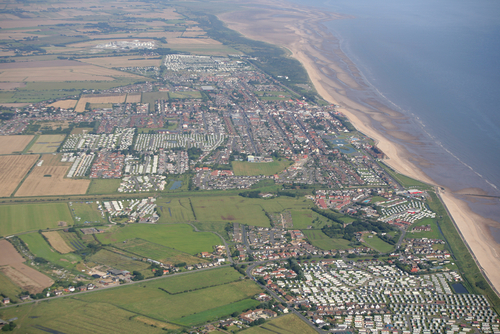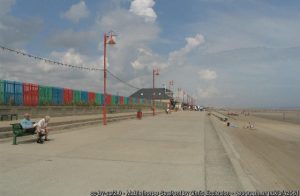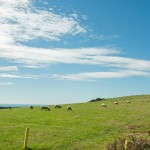
Mablethorpe is a seaside town and civil parish in the East Lindsey district of Lincolnshire, England. It lies on the east coast of England facing the North Sea, 28 miles (45 km) south of Grimsby and 17 miles (27 km) north of Skegness. The town is known for being a favoured destination of famed 19th-century Poet Laureate, Alfred Tennyson.
Up to the 12th century, like much of the Lincolnshire coast, the town’s shoreline is thought to have been protected from the full ferocity of the North Sea by a series of protective coastal islands. The islands appear to have created a sheltered tidal lagoon between themselves and the main coastline, which was characterised by salt marshes, wide sands, mudflats, tidal creeks, and estuaries.

A Fleeting History Of Mablethorpe
Mablethorpe is known to have existed as a settlement since millennia. Tellingly, archaeological investigation in and around the town has unearthed a horde of Roman artefacts.
According to one school of thought, Mablethorpe achieved its designation from the great number of maple-trees that once grew in the area. However, another source claims that the town derives its name from the Old German personal name of ‘’Malbert’’ and the Viking word “thorp”, meaning settlement. Thus, Mablethorpe was once a hamlet, owned and ruled by Malbert. The name dates to at least the time of the Domesday Book (1086) where it was listed as Malbertorp. Spelling variations of the town’s name over the centuries have included:
Maplethorp, Maplethorpe, Mablethorp, Mablethrope, Maplethrop, Maplethropp and Mablethropp!
In the early 12th century it’s known there were only about 40 adults living in the Mablethorpe area. Nonetheless, in 1253, the Lord of the Manor, David de Monte Alto, was granted a charter by Henry III to hold a weekly market at Mablethorpe. The next major event for the town was the founding of the original St Mary’s Church, which was built in the late 13th or early 14th century. The building of Mablethorpe Hall followed sometime during the 14th century, established as the baronial seat of the Fitzwilliam family. In 1349, a major outbreak of the plague, which had swept across the country, had a dramatic effect on the small farming community of Mablethorpe. The town saw about a third of its small rural population succumb to the disease.
Storm Surges
The significant storm surges of 1287 and 1288 are generally considered to have finally destroyed the offshore barrier islands and caused significant damage to the Lincolnshire coast, including the neighbouring medieval parishes of Mablethorpe St Peter and Mablethorpe St Mary. The sea continued to be a destructive force on the Mablethorpe area throughout the rest of the Medieval period, with major floods wreaking havoc in 1335, 1425, and 1444. In 1500, the Commissioners of Sewers for the province of Lindsey pronounced that both Mablethorpe and Skegness appeared to be ‘in very great danger of the sea’. In the late 1530s, it was recorded that “the church of St Peter, the village of ‘Mawplethrop’, and the greater part of its parish were ‘overflown with water in the sea’ and never recovered.”
The constant storm damage obviously had a great effect on the Mablethorpe’s development, as records show that in 1602, the population was still only 157. And, in 1801, the time of the first national census, little had changed, since the number of inhabitants in the town was recorded as only 164. However, over the 19th century, there was steady growth in population, such that in 1856, a national school was built in the town. By 1881, the town’s residents had grown to 640 and the school had around 100 pupils.
Here Comes The Train
One reason for the continuing growth of the town was the arrival of the railway in 1877. The Louth and East Coast Railway built a branch line of just under 12 miles from the mainline at Louth to Mablethorpe to cash-in on the growing seaside tourist industry. This was followed by the opening of the 7-mile Willoughby to Sutton-on-Sea branch line in 1886. The Willoughby Railway and Dock company had planned to create a large fishing dock at Sutton le Marsh to rival Grimsby but were unable to find sufficient backing for the project. The company then decided to build the connecting 2 miles from Sutton to Mablethorpe, completing a loop of the mainline between Willowby and Louth. However, the two small railway companies soon fell into financial difficulties and sold off their concerns to the Great Northern Railway (GNR) in 1902.
Though local passenger travel on the line was never significant, Mablethorpe benefitted considerably from its railway connection. GNR were instrumental in promoting the town as a tourist destination, running special excursions from the Midlands, and later London. However, not only tourism benefitted, as local farmers now had a means by which they could transport animals and produce to market far easier and cheaper than they could previously, via road. The opening of the railway also brought the new industry of shipbreaking to Mablethorpe and Sutton-on-Sea. As it was a time when wooden sailing ships were rapidly being replaced with iron, steam-powered ones. Many local builders and farmers made good of the spoils from the breakers’ yards, employing the materials in construction.
The 20th Century
Developments in Mablethorpe in the late 19th century saw a pavilion built in 1884, a coast guard station in 1886, and the formation of an Urban District Council in 1894. By 1901, the population of Mablethorpe had reached 934. In 1906, a council elementary school opened to cope with growing demand for places.
During WWI, a total of 31 servicemen from Mablethorpe either died or went missing during the conflict. A monument was erect in High Street soon after the war ended to commemorate their sacrifice. In July 1942, Mablethorpe was the target of a bombing raid by the Luftwaffe. The attack saw 4 houses completely destroyed, with 10 other homes being extensively damaged, and 6 people suffering varying degrees of injury.
The Modern Era
In January 1953, there was a massive North Sea flood, which was the worst inundation that England and Scotland suffered, during the 20th century. The worst part of the Lincolnshire coast affected was the stretch between Mablethorpe and Skegness. Nationally, over 24,000 homes sustained severe damage and 307 people lost their lives. On 31 January 2013, the 60th anniversary of the disaster, a granite rock memorial was unveiled at Mablethorpe Skatepark on the North Promenade in memory of the town’s 42 victims.
In 1970, Mablethorpe saw its train station close as it became a victim of government cuts in rail transport. The station was eventually converted to a sports centre.
Mablethorpe has no large businesses. It also has less small and medium-sized businesses per capita than the national average. However, of its businesses, 87% employ less than 10 people. The main employers in Mablethorpe are the tourist and retail sectors. In 2018, the town’s population, including the nearby village of Sutton-on-Sea, was estimated at 12,628.
Two Events For Your Diary
A notable couple of days in the Mablethorpe annual calendar is the country’s only beach-hut festival. ‘Bathing Beauties’ is held in the September of each year and runs alongside a 2-day craft market. The private owners of the beach huts compete for the best design. There’s also music, street entertainment and fireworks. Other big events are the Mablethorpe motorbike sand races which take place in winter and spring. Additionally, the Mablethorpe and Sutton-on-Sea Bike Night is held at Trusthorpe Festival Fields in mid-July. Mablethorpe’s illuminations “switch on” event takes place at the end of July each year. It’s accompanied by fireworks, and a celebrity, who’s obviously invited to execute the ”switch on”.

Mablethorpe hosts motorbike sand racing during Winter and Spring Image gill kennett/shutterstock.com
Getting To Mablethorpe
If its seaside town therapy you are looking for we better tell you how to get here:
By Road
There are various ways to get to Mablethorpe. From the North, the easiest way is probably to take the M180/A180 towards Grimsby, then follow the A18/A16 to Louth, and finally the A157/A1104. From the Humberside area take the A16 to Louth and then the A157/A1104. From the South and Midlands take the M1 or A1, then turn onto the A52 at either Nottingham or Grantham. At Louth follow the A157/A1104 to Mablethorpe.
By Train
Mablethorpe does not have a train station. The nearest facility is at Skegness about 17 miles away. There’s a regular bus service between the two towns which takes a little less than an hour.
By Bus
National Express operate 2 buses a day from London directly to Mablethorpe. They both leave around lunchtime and the journey takes about 6 hours. You will need to change buses to get Mablethorpe from most other destinations in the country.
By Air
The nearest airport to Mablethorpe is Humberside which is 41 miles (66 km), however, it has a limited flight schedule. The closest large facility is East Midlands Airport, which 97 miles (155 km) away.
Did you know?
- Mablethorpe is the destination for the Morel family holiday in D. H. Lawrence’s novel, Sons and Lovers. The book was first published in 1913.
- Mablethorpe provides the seaside setting for the Ted Lewis crime-fiction novel, GBH. Considered by some as his best book, the main backdrop is London’s 1970s criminal underworld. Lewis died in 1982 of alcohol-related problems aged only 42 years old.
- Mablethorpe is the only place in the country that hosts an annual beach hut competition.

Mablethorpe promenade with its famed beach huts Image: cally robin/Shutterstock.com
Notable People
- Hugh Whistler (1889 – 1943) – was a soldier, police officer and ornithologist who lived and worked in India between 1909 and 1926. It was there that he became interested in birds, documenting its populations and species in his journals. He was born n Mablethorpe on 28 September 1889.
- Sir Thomas Fitzwilliam (unknown – 1497) – was a member of Henry VIIIs first government. He was Speaker of the House of Commons in the English parliament between 1489–1490. He was born and died in Mablethorpe, being buried in St Mary’s graveyard.
Sport In Mablethorpe
Football
Mablethorpe Athletic FC first XI currently plays their football in the East Lincs Combination Division 1. They play their home games at the Sherwood Road Ground.
Things to do!
- Maplethorpe Beach – is an immaculate long, wide stretch of soft golden sand. Edging the Blue Flag award-winning beach, you’ll find the promenade with a fairground, cafes, fish and chip shops, crazy golf, donkey rides.
- The Promenade stretches beyond Sutton-on-Sea, making it ideal for walks and bike rides.
- The Sand Train – runs from the town’s Central Beach to North Beach. The round trip takes about 20 minutes and cost £2 per passenger. Small children and dogs travel free.
- On your Marques – is a privately owned model car and motor-racing museum. It exhibits around 6,500 model cars, along with a collection of car-themed memorabilia from movies and the world of motor racing. The Pit-Stop cafe serves hot and cold drinks as well as snacks. The museum is also located at Alford.
- Lincolnshire Aquapark – is an adventure park set in the Fen wetlands. There’s a variety of inflatable playground features and obstacles. It’s open from May to early October and suitable for all those 5 years+.
Places to Visit
If you are staying over then you should put a trip to nearby Alford on your itinerary it’s about 6 miles out of town but offers the following:
- Alford Windmill – is a working mill that dates from 1837. It opens to the public on given dates throughout the year. You get the chance to taste the freshly ground flour as there is a bakery on site.
- Manor House – is an early 17th-century country house. It’s thought to have the largest thatched roof in the country. The outbuildings house a Museum of Rural Life, and there’s also a bootmaker, a blacksmith’s shop and various farm machinery from yesteryear on site. The village of Alford is about 6 miles out of town.
If You Like Animals
- Radcliffe Donkey Sanctuary – is a non-profit organisation situated in the nearby village of Huttoft. Children are welcome to feed the donkeys. It opens Tuesday to Thursday and weekends throughout the summer months. There’s a small cafe on site.
- Visit Mablethorpe Seal Sanctuary and Wildlife Centre – a small zoo that rescues seals and seabirds. The centre also houses primates, reptiles, cats, ponies, a number of exotic mammals, and birds of prey.

Image: Oscar Johns/Shutterstock.com
Where to stay?
The main type of available accommodation in Mablethorpe are guesthouses and caravan park holiday lets. Some of the chalets/static caravans can sleep up 6 people, with the price being reflected in the number of available beds. There are also a few inns in the town but if you want to stay in a hotel you will probably have to stay in Louth or Skegness which are 10 or so miles away. For night in a double room in either a guesthouse, inn or chalet in Mablethorpe itself, expect to pay £50 to £70.
Thinking of moving To This Idyllic Seaside Town?
Are you thinking of moving to Mablethorpe? The average price of residential property in the town stood at £182,900 in November 2020. This is a rise of 9% in the last year when compared to prices for the previous 12 months. In terms of different property types for Mablethorpe, according to best estimates, flats sold for an average of £102,000, terraced houses for £137,600, semi-detached for £149,300, and detached for £212,000.





